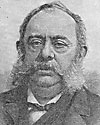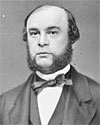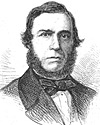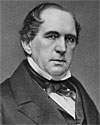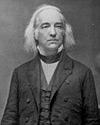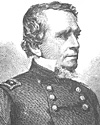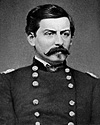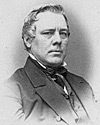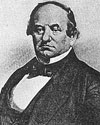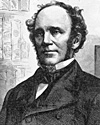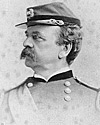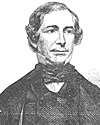President Lincoln told a visiting Democratic politician from New York: “I have heard some things from New York and if they are true, one might well say to your party there, as a drunken fellow once said when he heard the reading of an indictment for hog stealing. The clerk read on until he got to and through the words, ‘did steal, take and carry away ten boars, ten sows, ten shoats and ten pigs,’ at which he exclaimed: ‘Well, by golly, that is the most equally divided gang of hogs I ever did hear of.’ If there is any other gang of hogs more equally divided than the Democrats of New York are at this time, I have not heard of it.”1
It was fortunate for New York Republicans that New York Democrats had a long and bitter history of factionalism. “New York City could roll up large Democratic majorities but no Democratic faction could fully control the party,” wrote historian Paula Baker.2 Historian Sidney David Brummer wrote: “The Republicans were far more united in 1860 than were their adversaries. The factional struggles within the Democratic ranks in New York State were at this time deep-seated, of some years’ existence, and apparently incurable.”3 New York State had a strong Democratic tradition — and a strong tradition of Democratic feuding. New York States Democrats were split into two factions that dated back to the 1848 presidential election when former Democratic President Martin Van Buren ran as the Free-Soil Party’s candidate for President. Those Democrats who welcomed back Van Buren’s Free-Soil defectors after the election were called “Softshell.” Those who did not were called “Hardshell.” The split lasted until the Civil War and played a major role in the Democratic National Convention in 1860.
But those were hardly the only Democratic splits. The party had been dominated for years by the “Albany Regency” — upstate Democrats descended from the machine of erstwhile President Martin Van Buren. The Regency had strong business links — especially to the New York Central Railroad — and was led by Democrats like Dean Richmond and Erastus Corning, who were executives of the New York Central. The state party was ruled by a triumvirate, according to historian Stewart Mitchell: State Chairman Dean Richmond, a Buffalo businessman; State Secretary Peter Cagger, an Albany attorney; and Albany Atlas & Argus owner William Cassidy. Mitchell wrote: “Erastus Corning, iron manufacturer and president of the New York Central, and August Belmont, American agent of the Rothschilds in New York, supplied and managed the party funds. To these men should be added Samuel J. Tilden, once a Barnburner and now an expert reorganizer of railroads, and Fernando Wood, a Quaker, who began his career as a cigarmaker and rose from grocer to be mayor of New York and a member of the Congress.”4
New York Democrats were sometimes distracted by a much more mundane matters — railroad development. Several top Democrats — Peter Cagger, Corning and Richmond were railroad executives who needed Republican votes in the State Legislature to promote their railroad interests. According to historian Glyndon Van Deusen, “Ties binding finance and politics together stretched more and more often across party lines. There was scarcely a prominent Democrat in the state who was not under personal obligation to [Republican boss Thurlow] Weed, declared the great Democratic lawyer, Samuel Barlow, in 1860, and the remark was not hyperbole, Thomas W. Olcott, old-time Democrat and banker, was free to ow[e] his grateful appreciation of Weed’s ‘friendly and valuable services.’ Democratic Governor Horatio Seymour demonstrated on more than one occasion an earnest disposition to meet Weed’s wishes in signing or discarding bills that affected financial interests.”5
In New York City, the party split was between Tammany Hall, of which Postmaster Isaac V. Fowler was “Grand Sachem”, and Mozart Hall, which was led by Tammany renegade Fernando Wood. Tammany Hall ruled New York City until it failed to fulfil the aspirations of Mayor Wood, who formed Mozart Hall in 1858 after he was defeated for reelection as mayor. Tammany had run its own candidate, Daniel Tiemann, against Wood under an improbable “reform” banner. Tiemann was a disaster as mayor and Wood was returned as mayor in 1859. The party split, however, continued.
Tammany experienced a second setback in 1859 when Postmaster Isaac Fowler’s mishandling of $150,000 in Post Office funds was discovered and he disappeared. Tweed biographer Alexander B. Callow, Jr wrote: “Fowler had served the party well and Tammany looked after its own. A United States Marshal, Isaiah Rynders, Tammany Hall to the bone and a former thug, went to Fowler’s hotel to arrest him, but stopped first at the bar, drank several whiskies, announced often and loudly what his mission was. By the time he reached the Postmaster’s room, Fowler had vanished. With Fowler gone, Tweed made his move. Exerting all his influence, he was successful in making James Conner the next Grand Sachem. By Tammany standards, Conner was eminently respectable: he was Irish, Catholic, and well-liked. Thus the Hall was back into safe hands, and Tweed could emerge as the champion of Tammany’s honors, by organizing efforts to rally and win back the disillusioned Catholics and immigrants.”6
Added to these Democratic divisions was the overlay of national politics on the eve of the 1860 elections. Former New York Senator Daniel S. Dickinson was a potential presidential candidate who was adamantly opposed to the Albany Regency. State Chairman Richmond was loyal to Illinois Senator Stephen A. Douglas. Fernando Wood preferred an alliance with Southern Democrats as a way of undermining his New York rivals. At the 1859 state convention, “Wood tried by the aid of a select Mozart crowd to get control of the convention by a trick and by violence, the delegates withdrew from the hall, and later proceeded to organize. In this latter or ‘regular’ convention all but two delegates eventually participated. But Wood, with the aid of some up-state politicians, mostly former ‘hard-shells’ who hated the rule of the Regency, set up a rival convention,” noted historian Sidney David Brummer.7 Ever the opportunist, Wood was always looking for political advantage — and didn’t particularly care what alliances were necessary to advance his aims and interests.
It was in many ways, a cantankerous conclave. “The [Democratic] state convention, meeting in Syracuse in September 1859 was controlled by the Albany Regency, the ‘softs’ of former times, led by Dean Richmond and Peter Cagger, both strong Douglas men,” wrote Douglas biographer Robert W. Johannsen. “An alliance was struck with the ‘hard’ leader and enemy of Douglas, Daniel S. Dickinson, who favored conciliation and hoped for a Charleston delegation that would represent both groups. A slate of delegates was agreed upon, including twenty or so votes pledged to Douglas, with the remainder following Dickinson’s lead. The unit rule was adopted, thus giving Douglas the entire delegation for the time being.”8 But Dickinson had nursed his own ambitions for the presidential nomination and was not pleased with the course taken by State Chairman Richmond.
Although Douglas profited from this temporary “unity,” the divisions within the Democratic Party were actually deepened and New York City leader Fernando Wood tried to take advantage of the fissures by putting together his own delegation. According to historian Reinhard H. Luthin, “Richmond’s ‘soft’ faction and Dickinson’s ‘hard’ faction were at bitter odds. The ‘softs’ had trapped the ‘hards’ into allegiance with a promise of solid support for Dickinson for President — and then gagged them by a rigid unit rule at the Charleston convention in April. Dickinson was enraged at Richmond, who professed devotion to Douglas although waiting for a chance to put across Horatio Seymour as Democratic standard-bearer. On returning home following Douglas’s nomination at Baltimore in June, the embittered ‘hards’ held a monster mass-meeting at Cooper Institute, at which Dickinson denounced Richmond: ‘There is no fox so crafty but his hide finally goes to the hatter.'”9 Perhaps only political necessity spared Illinois Senator Douglas from similar treachery.
Critics of Dean Richmond’s leadership had repeatedly raised the specter of a Seymour presidential candidacy. According to Seymour biographer Stewart Mitchell, “Horace Greeley took up the cry of alarm in August [1859]. Seymour was to be put in training to receive the nomination at Charleston, ‘a contingency very likely to arise in that body.’ The game was to have the New York delegation act as a unit and ‘talk softly’ in favor of Douglas, of Hunter, or of Guthrie, offering thirty-five votes for the support of any one of these three in exchange for a seat in the Cabinet for Seymour.”10 Mitchell wrote: “It was said that Richmond’s plan of action at Charleston was to vote the delegation for Senator Douglas until the latter withdrew and then nominate Seymour with the aid of the South and the consent of the North West.”11
At the actual Democratic National Convention in Charleston in April, Fernando Wood brought his own delegation — which was not seated. Douglas biographer Damon Wells wrote that “Wood had represented a very real threat in what was perhaps the key state in the convention.”12 Only the pro-Douglas group headed by New York merchant Richmond and Cagger received recognition. The New York delegation remained firm in its support Douglas at the Charleston convention in April and the Baltimore convention in June. According to historian Brummer, “A number of Southerners had fought upon the floor for Wood; but the Douglas men stood steadily by the Regency delegates, and the presiding officer, a Douglas adherent, steadily ruled in their behalf.”13
In the delegation’s internal vote, Dickinson had received only 20 votes to 37 for Douglas — thus the entire delegation’s vote was cast for Douglas under the unit rule.14 But some Democrats thought that the Regency’s support for Douglas was a ruse. “They were subsequently accused of manoeuvring to hand the prize eventually to Horatio Seymour,” wrote historian Sidney David Brummer. “Very likely they would have been glad to take advantage of any opening for him, but it seems that they were sincerely for Douglas.”15 Historian Allan Nevins wrote:
For several reasons the New York delegates stood in the best position to effect a compromise. Their metropolis and State had an immense stake in the maintenance of the Union; the feeling of New York City was notoriously moderate; August Belmont and Dean Richmond had a host of Southern friends; and the persuasive John Cochrane had been prominent in national conventions for a quarter of a century. On Sunday, several New Yorkers, with at least one Southern peacemaker in the person of Richard Taylor, son of the former President, approached [John] Slidell and [Jesse D.] Bright. These Senators assured them that under certain circumstances and conditions the unity of the party could be preserved. They sent for [William L.] Yancey, and some evidence exists that he promised to try to persuade the other Alabama delegates not to bolt the convention immediately. Perhaps, in characteristic fashion, he merely uttered uncompromising words in such soothing tones that they seemed to suggest compromise. At any rate, while the conciliators labored, the Southern lines were actually being drawn tighter, and Virginia was coming to the side of the Lower South in insisting upon a slave-code plank.”16
Eventually, New Yorkers decided not to vote for slave code plank. When the slave code plank failed, Deep South delegations withdrew and the convention fell apart. Senator Douglas was grateful for New Yorkers’ support, but cautious before the second convention in Baltimore. He wrote Dean Richmond on June 22: “The steadiness with which New York has sustained me will justify a word of counsel. The safety of the cause is the paramount duty of every Democrat. The Unity of the Party and the maintenance of its principles inviolate are more important than the elevation or defeat of any individual. If my enemies are determined to divide and destroy the Democratic Party and perhaps the Country rather than see me elected, and if the Unity of the party can be preserved and its time-honored principles maintained and its ascendency perpetuated by dropping my name and uniting upon some other reliable, Non-Intervention, and Union loving Democrat, I beseech you in consultation with our friends to pursue that course which will save the Party and the Country, without regard to my individual interests.”17 The next day, Douglas wrote New York Democratic leader August Belmont to “express to you the obligation which I feel and am happy to acknowledge to the New York Delegation for their heroic firmness & fidelity to principle.”18
“In the weeks between the two conventions August [Belmont], through business contacts and friends, rallied moderate Southerners to Douglas’s support. He hoped a compromise resolution that defended the rights of slave-owners already in the territories might keep the party together, and he was sure, as he told Douglas, that Lincoln’s nomination at the Republican convention ‘must open the eyes of the South to the necessity of adhering to you.’ Lincoln, August thought, was an extremist and carried with him the threat of war,” wrote Belmont biographer David Black. “August himself rode herd on the wavering New York delegates, helped organize another mass meeting for Douglas at Cooper Union, established a committee of seven that solicited funds for the presidential campaign, and negotiated unsuccessfully to buy The New York Times in order to turn into a secure Douglas newspaper.”19
According to historian Reinhard H. Luthin, “The ‘hards,’ in open rebellion, met in convention at Syracuse on August 8, appointed a state committee, denounced Richmond’s leadership at Charleston and Baltimore, nominated James T. Brady for governor — and selected a Breckinridge-Lane electoral ticket and adopted a pro-southern platform. Since Breckinridge would secure one hundred and twenty-seven electoral votes in the South and on the Pacific coast, according to Dickinson, this made the election depend on New York. Dickinson called upon the ‘national’ Democrats to force Douglas out of the race.”20 Negotiations for Democrats to unite behind one anti-Republican candidate continued until October. Historian Glyndon Van Deusen noted: “If the Douglas-Bell-Breckinridge electoral ticket there concocted could carry that state, Lincoln would not have a majority in the electoral college, and the election would go into the House of Representatives, where in all probability he would defeated.”21
“It was recognized that the capture of New York’s electoral vote would be decisive,” wrote the authors of A History of New York State. “In an effort to secure New York against Lincoln, Washington Hunt and Horatio Seymour arranged for a fusion of the Douglas and Bell electoral tickets. This maneuver was known as the ‘Syracuse juggle.’ Later the Breckinridge forces were brought into the fold and a Fusion Ticket was established which proposed to divide the electoral votes: Douglas, 18, Bell, 10; Breckinridge, 7. The Fusion Ticket, which Greeley dubbed the ‘Confusion Ticket,’ was a real threat to Republican aspirations.”22 Horatio Seymour biographer Stewart Mitchell wrote: “The makeshift of the fusion electoral ticket which resulted was one of the oddest political contraptions that has ever been devised.”23 Nevertheless, the Republican president and gubernatorial candidates carried the state by over 60,000 votes.
In the wake of their defeat, Democratic leaders in New York proved unenthusiastic Unionists in early 1861. Mayor Fernando Wood proposed that New York City itself secede from the state and nation and become a free city. Former Governor Horatio Seymour thought that secession was a legitimate right. They temporized right up to the Confederate attack on Fort Sumter. That attack caused a major upheaval in the New York Democratic Party. According to historian Irving Katz, “Many pre-Sumter Democrats now pledged full, unqualified backing to the administration, either as self-styled ‘War Democrats,’ as full-fledged Republicans, or as members of the Republican-sponsored ‘Union Party.’ Gone from the regular Democratic fold were such enormously popular vote-getters and spokesmen as [Daniel E.] Sickles, Daniel Dickinson, John Van Buren, and John A. Dix of New York and Benjamin F. Butler of Massachusetts. Because Belmont and other traditional Democrats refused to dissolve what they considered their constitutional function as a loyal opposition, the misapprehension arose that they were ‘anti-Union’ or ‘non-Union’ Democrats. But they saw nothing disloyal in presenting alternatives to military suppression of the South, believing as they did that Republican policies could not lead to the Union’s restoration. Whatever the intrinsic merits of this approach, a national temper which equated criticism with disloyalty was bound to affect the election results.”24
According to historian Daniel Van Pelt, “Nothing so well illustrates the magic effect of unifying all men and parties at the North, produced by the guns fired on Fort Sumter, as the change that came over the municipal Government of New York. Hardly was the ink dry upon the message of Mayor Wood, seriously proposing the secession of New York City, when the same Common Council who had hailed the proposition with fervid applause passed resolutions pledging sympathy and support to the Union cause. And these were drafted by General Daniel E. Sickles, who a few months before had threatened in the House of Representatives that the secession of the Southern States would be followed by that of New York City. By these resolutions Mayor Wood and his Council invoked ‘the unselfish patriotism and the unfaltering loyalty which have been uniformly manifested in all periods of National peril by the population of the city of New York; and they felt they were giving expression to the sentiments of their constituents by declaring ‘it to be their unalterable purpose, as it is their solemn duty, to do all in their power to uphold and defend the integrity of the Union, and to vindicate the honor of our flag, and to crush the power of those who are enemies in war, as in peace they were friends.”25
“There is evidence that some prominent Democrats in New York State were swept along by the revolutionary tide most unwillingly,” wrote historian Sidney David Brummer. “Francis Kernan, then the Democratic leader in the Assembly, having been absent from the session of April 15th, made a speech on the following day, in which he declared that because he believed there was danger of attempts on the national capital, he favored furnishing the federal government with means to repel such an aggression. ‘But,’ he continued, “I am opposed to, and I trust the National Government will not attempt to carry an aggressive war into the Southern States. Such a war will neither preserve or restore the Union.”26
Many Democrats grew more reluctant to support the war as the initial fervor after Fort Sumter subsided. The issuance of the draft Emancipation Proclamation in 1862 and the suspension of civil liberties in military arrests also alienated some Democrats. “Democrats were more thoroughly divided, much as they had been before the fighting broke out,” wrote historians Edwin G. Burrows and Mike Wallace. “‘War Democrats’ — who included prominent businessmen and the bulk of Tammany Hall politicians, among them [William Marcy] Tweed — favored fighting on to victory but opposed partisan Republican legislation and the Lincoln administration’s erosion of civil rights. ‘Peace Democrats,’ rooted in Fernando Wood’s Mozart Hall, wanted to restore the Union as it had existed before the war, with slavery intact, though a more extreme wing was prepared to accept peace without reunion.”27
“On the 6th of August [1861], the Republican State Committee invited the Democratic State Committee to call the Democratic State Convention at the same time and place as the Republican convention, in order that they might unite on a Union ticket pledged to ‘a vigorous prosecution of the war, for the restoration of the authority of the constitution and the execution of the federal laws in all sections of the country.’ This move was both patriotic and magnanimous, the offer coming from the stronger to the weaker side. It was also wise politically, since its rejection by the Democrats would rightly expose the latter to the charge of fostering divisions of the North. Indeed, if the Democrats were in favor of the war to maintain the constitution — as they constantly averred — the platform proffered was one upon which both parties might well have joined without sacrificing the principles of either. Such a result would have strengthened the administration in its efforts to subdue the rebellion, and very likely would have aided in bringing about similar action in other states. Thus there might have been formed a Union party whose only opponent in the North would have been the peace advocates. That the politicians who controlled the organization in New York failed to rise to such an act of statesmanship is not astonishing when on considers the force of party ties, the power of the idea of preserving the party machinery, the repugnance of the ‘black Republican’ party, and the hope of gaining advantages over it in the future.”28
The inability of the Democrats to define themselves hurt their 1861 statewide campaign. At a State Democratic Convention in early September, Peace Democrats passed a platform which contained the following resolution: “We protest against the doctrine that any power except the representatives of the people can suspend the writ of habeas corpus for civil offences. We protest against the assumption of the executive power to establish a system of passports; against the right of the federal government to organize systems of State police; against the assumption of the federal executive to suppress the discussion of a free press, by the refusal of mail facilities, or in any way except the decisions of the civil tribunals; and that, finally, we protest against the doctrine of President Lincoln’s message, that the States derive their authority from the federal government, as subversive of the fundamental doctrine of American liberty.”29
Although controversial in the 1861, the substance of the Democratic resolution proved a winning formula a year later. The high point of Democratic fervor was the 1862 gubernatorial election which capitalized on anti-emancipation, pro-civil liberty feelings in the New York State, especially in New York City. “The mass of the Democrats, however, refused to go into the Union party,” wrote historian Brummer. “For this, the leaders and especially the Regency were to blame. Had their action in September, 1861, been the reverse of what it was, it is not unreasonable to suppose that political contention in New York might have been stilled until the middle of the next year if not longer.”30
By mid-1862 the political mood had changed. Historian Allan Nevins wrote: “On the evening of July 1, [1862] the day of Malvern Hill, a mass meeting of discontented New Yorkers gathered at Cooper Union to listen to ex-Mayor Fernando Wood, Representative James Brooks, and the jurist William A. Duer, son of a former president of Columbia, as they denounced the government in the most waspish Democratic style.”31
The splits among New York Democrats took a particularly strange twist during the 1862 gubernatorial campaign in which former Governor Horatio Seymour faced off against General James Wadsworth, the Republican candidate. “General Wadsworth remained conspicuously absent at the front all during the campaign of 1862; so Seymour exchanged the compliments of debate chiefly with old ‘Hards’ like [former Senator Daniel S.] Dickinson and [Lyman] Tremaine, not Barnburners like [John A.] Dix,” wrote historian Stewart Mitchell. “The Democratic candidate was effectively adroit in pointing out how absurd it was for him to be called a traitor by the very men who had not only voted for [John] Breckinridge in 1860 but sat on the platform of Tweddle Hall during the first days of secession. He reminded the public that many of the most furious foes of secession had broken up abolition meetings in the days before the Civil War, and had even heckled one in a church in Utica against his own protest.”32
In 1863, the split between Republicans and Democrats widened further. “The peace movement continued to build after the full [Emancipation] Proclamation was issued. On February 6, 1863, at Delmonico’s, a group of Democratic and ex-nativist businessmen led by financier August Belmont launched the Society for the Diffusion of Political Knowledge,” wrote historians Edwin G. Burrows and Mike Wallace. “Other luminaries included the venerable Samuel F. B. Morse (president), Governor Seymour, and corporate attorney Samuel J. Tilden. The organization published antiwar and antiemancipation tracts in which they suggested that freeing the slaves would ruin the South (and indirectly the North) by undermining its ability to compete with slave economies like Brazil or Cuba.”33
Historian Sidney David Brummer wrote that mainstream Democrats condemned conscription and sought ways that they could undermine it: “The New York Democrats, in their blindly partisan feeling against the national administration, overlooked the fact that their own State had come very near resorting to a draft in the previous year, that volunteering had almost ceased, and that the Confederacy was filling its armies by a most tyrannical conscription.”34According to Brummer, “During the early months of 1863, the peace faction — until then very weak in New York State — began to grow. The rise of Copperheadism here was marked by disloyal utterances at Democratic mass-meetings and in Democratic newspapers. In March [Ohio Congressman Clement] Vallandigham addressed a rather sparsely attended gathering in New York City.”35
Leading the move toward Copperheadism was former New York Mayor Fernando Wood and his Mozart Hall faction of the New York City Democratic Party. At a March 1863 meeting of Mozart Hall, Wood declared: “We are for making men in power conform to all the laws of the constitution before we are required to conform to statutes that are no law and which are inconsistent with the constitution.” He declared that loyalty had no meaning in a democracy and that “There is no such thing as a war Democrat.”36 The arrest and expulsion through Confederate lines of former Ohio Congressman Clement Vallandigham in May 1863 further exacerbated the fissures in the New York Democratic Party. “The Copperhead demonstrations occasioned by the Vallandigham affairs had another significance,” wrote historian Sidney David Brummer. “It marked a renewal of the struggle within the Democratic ranks in New York State between Fernando Wood and the Regency. The speeches and resolutions of the New York City meeting compared with those of the Albany or Buffalo meetings showed the difference between the factions. While Wood and his followers came out for peace, the Regency and their adherents declared themselves still in favor of a vigorous prosecution of the war for constitutional ends.”37
In late May 1863 the Democratic State Committee met and backed resolutions of non-confidence in the Lincoln Administration. A few days later, a mass meeting for “Peace and Reunion was held at Cooper Union. In an address formulated by Fernando Wood, it was declared: “The only road to democratic victory is through peace. Why should politicians fear that a peace party may prove unpopular. If the war has damned the republican party is it not logical to suppose that a peace policy might prosper the opposition? But this matter is beyond the control of the politicians. The great body of the people are tired of the war and demand peace….”38 Wood was an expert in the exploitation of public sentiment for his own personal benefit. He attempted to use the rally for his own political purposes, according to historian Sidney David Brummer, who wrote that “in the discontent of a certain element, Wood found a club to use against Tammany and the Regency.”39 According to Brummer, “To support the war and at the same time to condemn with the most intemperate criticism the administration which must carry on the war, as well as its measures for subduing the enemy, was pulling in contrary directions. It was but natural that the New York Democracy drifted toward the position of the Copperheads.”40
In early 1864 there was a meeting in New York of members of Democratic National Committee at Belmont mansion in New York City. John Waugh wrote in Reelecting Lincoln, “Belmont opened the meeting and told his colleagues that the Democratic congressional delegation in Washington, at his request, had wired a preference for the time and place of the party’s nominating convention. They had picked Cincinnati in May. Several committeemen, including Belmont, objected. Too early, they argued. If anything was working for the party it was time, the more of it the better — time to let further defeats on the battlefield, heavier taxes, and Lincoln’s conscription policies take their toll on the Republican incumbent. So the committeemen fixed on July 4 for the convention instead of May, a late date for a convention, but full of pregnant meaning. They also overruled the congressmen on place, choosing Chicago over Cincinnati, a tribute to Douglas.”41
According to Belmont biographer Katz, by the time New York Democrats held a State Convention in February 1864: “…four different New York City contingents turned up in Albany’s Tweddle Hall and demanded recognition. The convention decided once and for all to put an end to this chronic nuisance and adopted a resolution that state convention delegates from the downstate metropolis should henceforth be elected by State Assembly districts, not by rival groups like Tammany Hall, Mozart Hall, the McKeon Democracy, or the German-American Democratic Organization. The McKeon faction won the majority of the New York seats for the moment.”42 The situation deteriorated by the time state Democrats held a convention in September 1864. Historian Bummer wrote: “There being no less than six sets of contestants from Now York City, the committee on credentials reported a resolution acknowledging Tammany Hall as the regular Democratic organization and the Tammany delegates as the regularly elected ones, awarding them nine votes — more than half of those cast by New York County — and admitting the other delegations with one or two votes apiece.”43
New York Democrats were hopeful that the nomination of George B. McClellan would offer an opportunity for Democratic presidential victory in 1864. According to historian David E. Long, one problem the Democrats faced “was that former Governor Horatio Seymour of New York, having previously announced his unavailability, was now willing to be drafted. Seymour was a formidable candidate and the Copperheads preferred him to McClellan. McClellan’s managers immediately began attempting to hold the first-ballot commitments they had, to seek favorite-son delegates who would promise second-ballot support, and assure an early McClellan nomination with as little friction as possible. In the process, they completely neglected what would prove to be the most important aspect of the convention, the Committee on Resolutions, or, as it was more commonly known, the platform committee.”44
When the Democratic Convention convened in Chicago on August 29, the Democrats nominated George McClellan for President and Ohio Congressman George H. Pendleton for Vice President. Pendleton was a good fit with the Democratic Peace Platform but a bad fit with Democratic presidential candidate McClellan. As Democratic chances for victory grew, their potential for a split had grown as well. The Peace Democrats were emboldened. And Democrat prospects for victory were dashed.
But not for long. The political lines in New York State were not always clear. In late 1862 and early 1863, Republican political boss Thurlow Weed wrote complimentary letters to Democratic Governor Horatio Seymour. In late 1863 and early 1864, Republican Postmaster General Montgomery Blair occasionally unloaded his political opinions on such diverse personalities as Democratic stalwart S. L. M. Barlow and Republican editor Horace Greeley. But after President Lincoln’s reelection and murder, the old dividing lines in New York politics became clearer once again. Historian Sidney David Brummer concluded that by 1865 the splits in the Democratic Party had been largely healed: “The remnants of third parties had disappeared. Moreover, the old divisions between Douglas and Breckinridge followers had been healed, and no more was heard of ‘hards’ and ‘softs.’ So that outside of the metropolis the Democracy had gained unity since 1860; but this weakened the checks upon the power of the up-State leaders. Thus, while Tammany was still able to contend with the Regency, Mozart had been split into fragments, and the days when it was able to fight on a plane of equality with its rivals were over. At the end of the war, Dean Richmond’s ascendency was undiminished. Seymour’s influence had greatly increased. Although Fernando Wood was again to sit in Congress during the ten years following 1867, he had ceased to be the important factor in New York politics that he was in 1860. By 1865, [William Marcy] Tweed and [Peter] Sweeney had come to the front in Tammany.”45
Footnotes
- Don C. Seitz, Lincoln the Politician, p. 77.
- Milton M. Klein, editor, The Empire State: A History of New York, p. 423 (Paula Baker, “New York during the Civil War and Reconstruction”).
- Sidney David Brummer, Political History of New York State During the Period of the Civil War, p. 24.
- Stewart Mitchell, Horatio Seymour of New York, p. 209.
- Stewart Mitchell, Horatio Seymour of New York, p. 224-225.
- Alexander B. Callow, Jr., The Tweed Ring, p. 26.
- Sidney David Brummer, Political History of New York State During the Period of the Civil War, p. 29-30.
- Robert W. Johannsen, Stephen A. Douglas, p. 738.
- Reinhard H. Luthin, The First Lincoln Campaign, p. 212.
- Stewart Mitchell, Horatio Seymour of New York, p. 208.
- Stewart Mitchell, Horatio Seymour of New York, p. 209.
- Damon Wells, Stephen Douglas: The Last Years, 1857-1861, p. 218.
- Sidney David Brummer, Political History of New York State During the Period of the Civil War, p. 53.
- Sidney David Brummer, Political History of New York State During the Period of the Civil War, p. 56.
- Sidney David Brummer, Political History of New York State During the Period of the Civil War, p. 51.
- Allan Nevins, The Emergence of Lincoln: Prologue to Civil War, 1859-1861, p. 219.
- Robert W. Johannsen, editor, The Letters of Stephen A. Douglas, (Letter from Stephen Douglass to Dean Richmond, June 22, 1860).
- Robert W. Johannsen, editor, The Letters of Stephen A. Douglas, (Letter from Stephen Douglass to August Belmont, June 23, 1860).
- David M. Black, The King of Fifth Avenue, p. 189.
- Reinhard H. Luthin, The First Lincoln Campaign, p. 212.
- Glyndon Van Deusen, William Henry Seward, p. 234.
- David M. Ellis, Jams A. Frost, Harold C. Syrett, and Harry J. Carman, A History of New York State, p. 240.
- Stewart Mitchell, Horatio Seymour of New York, p. 214.
- Irving Katz, August Belmont: A Political Biography, p. 118.
- Daniel Van Pelt, Leslie’s History of the Greater New York, Volume I, p. 403.
- Sidney David Brummer, Political History of New York State During the Period of the Civil War, p. 148 (Albany Argus, April 17, 1861).
- Edwin G. Burrows and Mike Wallace, Gotham: A History of New York City to 1898, p. 885.
- Sidney David Brummer, Political History of New York State During the Period of the Civil War, p. 155-156.
- Sidney David Brummer, Political History of New York State During the Period of the Civil War, p. 162.
- Sidney David Brummer, Political History of New York State During the Period of the Civil War, p. 444.
- Allan Nevins, The War for the Union: War Becomes Revolution, 1862-1863, p. 169.
- Stewart Mitchell, Horatio Seymour of New York, p. 250-251.
- Edwin G. Burrows and Mike Wallace, Gotham: A History of New York City to 1898, p. 886.
- Sidney David Brummer, Political History of New York State During the Period of the Civil War, p. 288.
- Sidney David Brummer, Political History of New York State During the Period of the Civil War, p. 303.
- Sidney David Brummer, Political History of New York State During the Period of the Civil War, p. 305.
- Sidney David Brummer, Political History of New York State During the Period of the Civil War, p. 315.
- Sidney David Brummer, Political History of New York State During the Period of the Civil War, p. 318.
- Sidney David Brummer, Political History of New York State During the Period of the Civil War, p. 319.
- Sidney David Brummer, Political History of New York State During the Period of the Civil War, p. 445.
- John Waugh, Reelecting Lincoln, p. 88.
- Irving Katz, August Belmont: A Political Biography, p. 125-126.
- Sidney David Brummer, Political History of New York State During the Period of the Civil War, p. 415.
- David E. Long, The Jewel of Liberty, p. 61.
- Sidney David Brummer, Political History of New York State During the Period of the Civil War, p. 446-447.
Visit
August Belmont
Samuel L.M. Barlow
Montgomery Blair (Mr. Lincoln and Friends)
Montgomery Blair (Mr. Lincoln’s White House)
Erastus Corning
Daniel S. Dickinson
Stephen Douglas (Mr. Lincoln’s White House)
Manton Marble
George B. McClellan
George B. McClellan (Mr. Lincoln’s White House)
Dean Richmond
Horatio Seymour
Benjamin Wood
Fernando Wood






